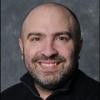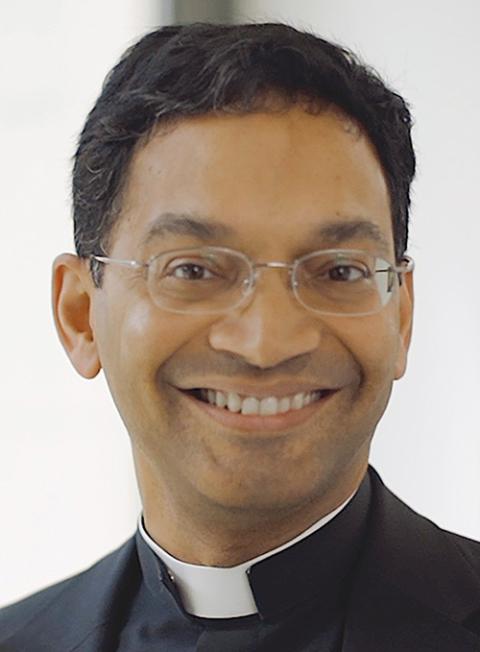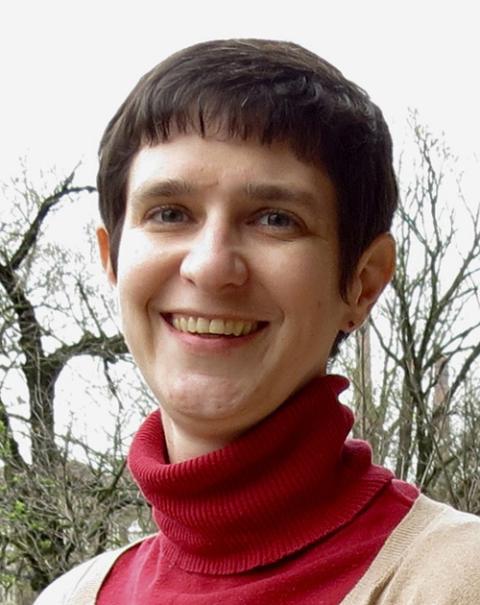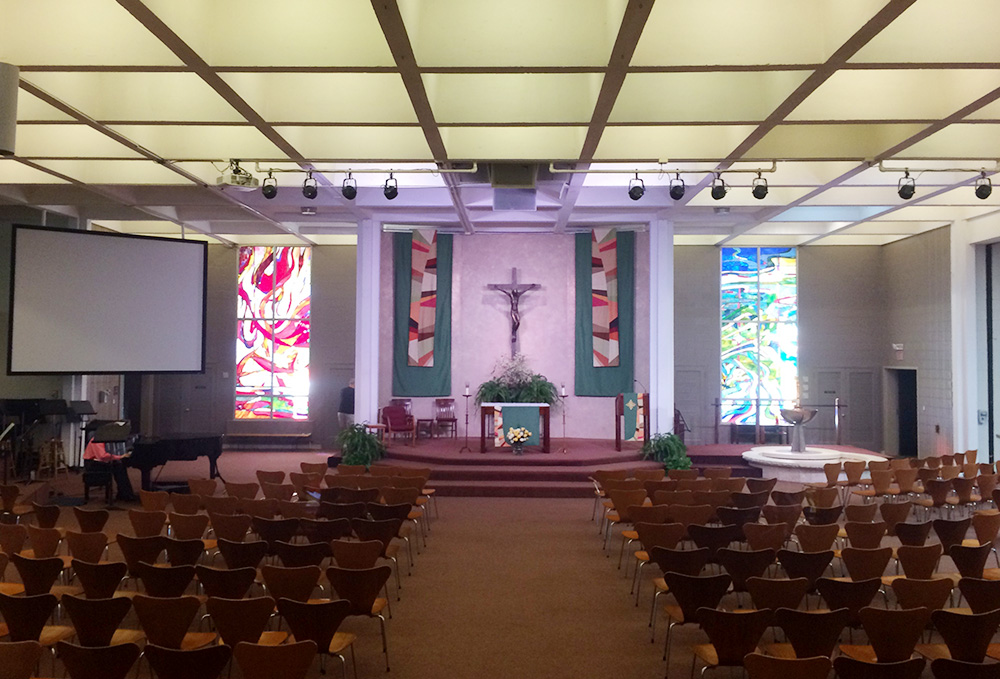
The interior of the St. Thomas More Newman Center in Columbus, Ohio, is seen in 2017. This year, the diocese is overseeing a $3 million renovation of the center. (Wikimedia Commons/Nheyob)
Like many others she worshiped alongside for decades, Beverly Orazen and her husband began attending the St. Thomas More Newman Center at Ohio State University in Columbus when they were undergraduate students there in the early 1960s.
"During the Cuban missile crisis, we went to Mass every single morning," said Orazen, who along with many of her friends were married at the Newman Center, baptized their children there, volunteered in various ministries over the years, and mentored generations of college students who attended Mass and socialized there during the academic year.
"It was a big and important part of our lives," Orazen told NCR.
Orazen and other longtime members of the Newman Center's resident community have tried to keep their group together after the Columbus Diocese, under the leadership of Bishop Earl Fernandes, evicted them in 2022 as part of an overhaul of the Catholic campus ministry program at Ohio State.
The diocese took control of the Newman Center's daily operations from the Paulist Fathers, the community of U.S. priests that had ministered at Ohio State University for more than 60 years. The diocese said it invited the Paulist Fathers to stay on as chaplains for one year, answering to a diocesan priest who became the campus ministry's executive director. The Paulist Fathers said the proposed arrangement was not conducive to their charism as a missionary society of priests.

Entrance sign to Ohio State University in Columbus (Dreamstime/Bryan Pollard)
At Fernandes' direction, the diocese changed the campus ministry's focus from a program that incorporated a year-round resident community of retirees and middle-aged adults with children to a model where only college students, ministry staff members and young adult campus missionaries participate.
Community stays connected
While some have started to attend Masses at local parishes in and around Columbus, several former Newman resident community members still gather monthly for "discernment meetings" where they pray and sing together, share their thoughts and experiences, and discuss where they are on their individual and collective spiritual journeys.
"It has made the synodal process a real-life experience for me," said Marianne La Rosa, who attended the Newman Center for 36 years and met her husband there shortly after she finished graduate school.
"The one thing that we had a strong desire to do is stay connected as a community. And to do so, by incorporating everyone, no matter what their personal journey is at this point in time," said Greg Stype, a longtime member and leader in the Newman resident community.
"There are people who have found new opportunities both within the Catholic Church and outside of the Catholic Church, and they're bringing that experience to our group. Then there are people who are fighting anger and grief as well, and that's all very understandable," Deb Stype, who is married to Greg, told NCR.
'One of the gifts of all of this has been to see even more so the holiness of this community.'
—Mary Ellen Thomas
Though they lost their spiritual home, Newman resident community members still maintain their established faith-building and social service ministries, including a St. Vincent de Paul Society, Catechesis of the Good Shepherd, prayer groups, Bible studies and support initiatives for programs that provide shelter and transitional housing.
Describing herself as a naturally skeptical person, Orazen said her years being involved with the Newman Center introduced her to the Bible and Catholic mystics in a manner that made her "believe everything."
"It was the time when my faith was the strongest, and the deepest, and for that very important reason I am very interested in maintaining my connection to people who have made such an impact in my life," she said.
Mary Ellen Thomas, a former Holy Cross religious sister who attended Mass and volunteered in a variety of roles at the Newman Center for 32 years, told NCR that the Newman resident community is "such a holy group."
"I used to say to the guys on staff that this community was full of holiness," she said. "And I think one of the gifts of all of this has been to see even more so the holiness of this community."
Advertisement
Greg Stype dated his wife, Deb, in the early 1970s when she was an undergraduate student at Ohio State University attending Mass at the Newman Center. Stype began attending Mass with her there and later enrolled in the center's RCIA program to enter the Catholic Church.
"And we raised our two daughters at the Newman Center," Greg Stype said.
A growing number of the estimated 400 Newman resident community members have become Paulist Associates, the group of lay men and women who identify with the Paulist Fathers' charism.
For a few weeks after being evicted from the Newman Center, community resident members met at a local theater to livestream Sunday Mass from the Church of St. Paul the Apostle, the Paulist Fathers' home parish in New York City.
"It's been great to see this wonderful little community that's developed in Columbus," said Paul Snatchko, a spokesman for the Paulist Fathers who told NCR that the Paulist priests who served at Ohio State University have all moved on to other ministries.
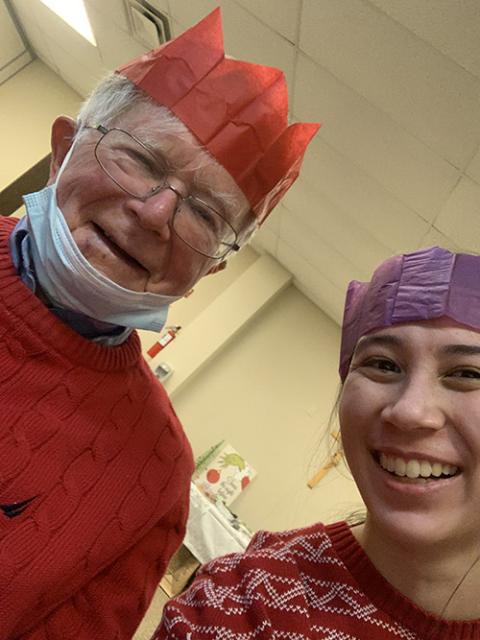
Ohio State senior Julia Dreiling with 92-year-old Paulist Fr. Vinny McKiernan, who she says "is like a second grandfather to me" (Courtesy of Julia Dreiling)
One priest, 92-year-old Paulist Fr. Vinny McKiernan, lives with a local couple in Columbus. He served at the Newman Center for more than 30 years.
"Father Vinny is like a second grandfather to me," said Julia Dreiling, a 21-year-old senior at Ohio State University. Like many in Columbus, she still keeps in contact with the Paulist priests who served there in campus ministry.
A few of the Paulist priests have returned to Ohio over the past year for baptisms, weddings, retreats and special Masses for the Newman resident community. Some resident community members still have the Paulist Fathers' cellphone numbers on speed dial.
The bishop's vision
Fernandes, who became the bishop of Columbus in May 2022, said at the time that the changes to the campus ministry at Ohio State University was the "first step in an exciting and renewed vision for vocations and evangelization" in which the Newman Center would "play a vital role."
In a memorandum that NCR obtained in 2022, the diocese signaled that it planned to take the campus ministry program in a more conservative direction. The memorandum cited groups such as Courage — an apostolate where some chapters use a 12-step model to encourage LGBTQ Catholics to abide by the church's teachings on chastity — and Opus Dei as examples of lay apostolates that would be welcome at the Newman Center.
The first post on the campus ministry's Facebook page after the diocese assumed control was a photo commemorating the 54th anniversary of Humanae Vitae, the 1968 encyclical in which Pope St. Paul VI reaffirmed the church's traditional teaching against artificial birth control.
A few weeks later, the phrase "All are welcome" — previously on the St. Thomas More Newman Center sign — had been painted over.
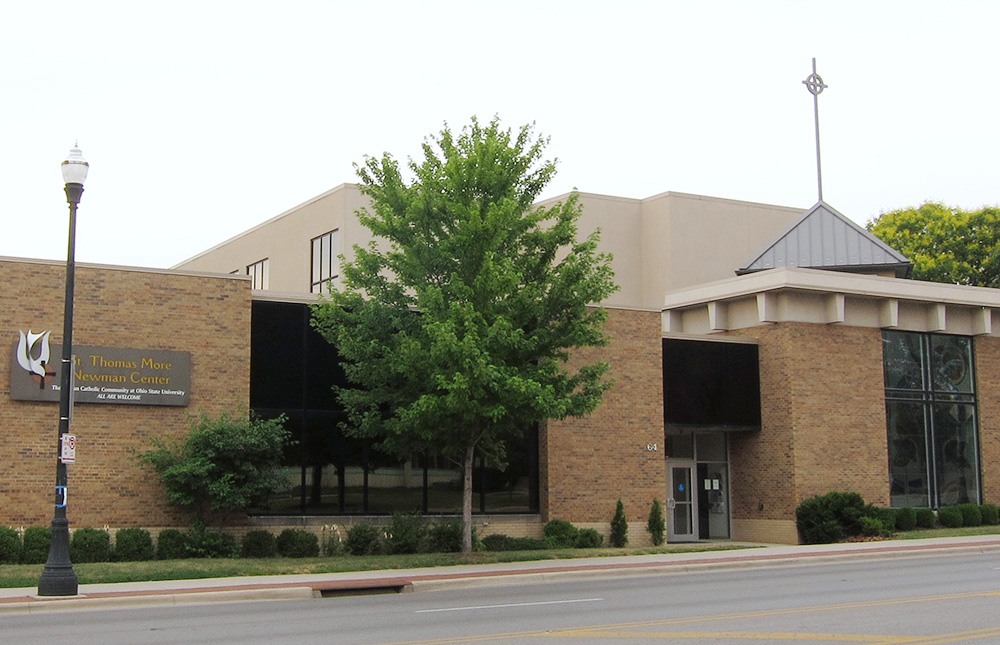
A 2012 exterior photo of the St. Thomas More Newman Center in Columbus, Ohio, shows the sign that read at the bottom, "All are welcome." (Wikimedia Commons/Nheyob)
An email that NCR sent to the current executive director of the Catholic campus ministry program was referred to a spokesman for the Columbus Diocese, who said the diocese was declining to comment for this story.
In a July 2022 interview with a local television news outlet in which he discussed the changes at the Newman Center, Fernandes said there were "a lot of good things that are going to happen." He urged people to "not let fear dominate" them, and to be open-minded.
But not everyone then or now in Columbus shares the bishop's vision.
Michelle Reese, a 32-year Newman Center member who raised her four children there, told NCR that she is concerned about her two younger children, both teenagers, no longer seeing other youths their age at Mass and not having the opportunity to establish relationships with adults who could serve as mentors.
"I'm not just dealing with my own faith journey, but I'm dealing with theirs and trying to keep them as connected to the church as they were a year ago," Reese said.
'For a lot of us, it's hard to be inside any Catholic church in Columbus, because every church in Columbus leads back to the bishop, and that's just a hard thing to be around.'
—Angie Harper
Dreiling, the Ohio State senior who was baptized at the Newman Center, attended faith formation classes and volunteered there when she was a teenager, said the events of the past year were still "too much" for her.
"The bishop never talked to us. There was no consultation with the community," said Dreiling, whose parents met and were married at the Newman Center. Her father participated in the music ministry for several years until the diocese assumed control of campus ministry.
'A front row seat to the destruction'
As a college student, Dreiling became a peer minister in the campus ministry program at the Newman Center, and said she found the experience to be "extremely rewarding" and beneficial for her faith.
But with the Paulist Fathers and the Newman resident community gone, Dreiling said she no longer attends Mass in the Columbus Diocese. She and others who spoke with NCR said Fernandes' actions, as well as online comments from some Catholics on social media, sent a message that made them feel like they were not good Catholics.
"It seems like all of [the Columbus Diocese] is being pushed in one direction, into one monolithic way of being Catholic, and there's no budging on that," said Angie Harper, a 21-year-old Ohio State senior who like Dreiling was involved with the campus ministry program and attended Mass at the Newman Center.
Harper said she has not been as involved in church since the changes to the campus ministry at Ohio State. She told NCR that she is now trying to figure out what she believes, and why.
"For a lot of us, it's hard to be inside any Catholic church in Columbus, because every church in Columbus leads back to the bishop, and that's just a hard thing to be around," she said.
Dreiling added that the turmoil around the Newman Center over the past year had hampered her mental health and led her to have panic attacks.
What has also not helped, Dreiling added, has been observing the $3 million in renovations that the diocese is overseeing at the Newman Center. Some stained glass windows — paid-for by the resident community in a previous renovation — have been removed, the sanctuary moved, office space converted into a student lounge, and a side chapel turned into a coffee shop.
Fr. Adam Streitenberger, executive director of the Newman Center, told the local diocesan newspaper in May that the renovations would set the campus ministry up "to grow the mission" and make the Newman Center "more conducive for student activity."
But Dreiling said watching the construction work near the campus made her feel like she had "a front row seat to the destruction" of her church.
Said Dreiling, "I see them taking down the stained glass windows of the chapel where I prayed for 20 years of my life, and it's going to be erased for some lattes and cappuccinos? It seems like it's all about the bishop's vision, what he wants, and what he considers to be Catholic or not."
Cynthia Clopper, a linguistics professor at Ohio State who attended Mass at the Newman Center, which is across the street from campus on Columbus' West Lane Avenue, told NCR that she faulted Fernandes for the manner in which he changed the campus ministry program.
"It's certainly his prerogative to change the leadership and the vision of the Newman Center, but I don't feel the way he did it was right," said Clopper, who criticized the bishop for not reaching out directly to the Newman Center's resident community or to the Catholics on the faculty and staff at Ohio State.
"There was no articulation of what our roles might have been in this new vision. To not articulate that all was really disappointing," Clopper said. "Having that kind of dialogue would have been a hard conversation, but a good leader would have done that."
In his local television news interview, asked why he did not speak with "members of the Newman Center who believe they've been left out of all of this," Fernandes said it was in part because he expected and hoped for a positive response from the Paulists. "Little did I expect then the reaction that came thereafter," he said.
In the same interview, Fernandes likened his role to that of a parent whose decisions sometimes anger their children. That comparison still rankles many of the adults with deep roots in the St. Thomas More Newman Center and several decades' worth of collective experience in serving their community and helping college-aged adults to make the Catholic faith their own.
"I grew up in the black-and-white church," Thomas said. "The way I see it, Vatican II made us all technicolor. I want the youth of today to know that technicolor church. At the Newman Center, we had the opportunity to share that. So I want the students today to see a technicolor church, but I fear they're not getting that."
